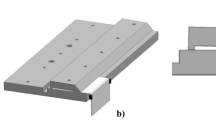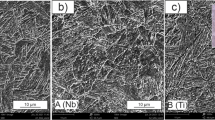Abstract
In this study, the thermal cycles and the grain structure in the weld heat-affected zone (HAZ) are predicted. At the first stage, a combined heat transfer and fluid flow model is employed to assess the temperature fields during and after welding of 304 stainless steel and then, the evolution of grain structure is conducted using the predicted temperature distribution and an analytical model of grain growth. The grain sizes of the CGHAZ (coarse grain heat affected zone) achieved from the model are basically in agreement with those obtained from experimental measurement under different heat inputs in the range of 0.33-1.07 MJ/m. Both the experimental data and the calculated results show that the average grain size near the fusion plane is about two to four times larger than the average grain size in the base plate depending on the applied heat input.








Similar content being viewed by others
References
J. Gao, R. G. Thompson, Real time-temperature models for Monte Carlo simulations of normal grain growth. Acta Metall, 44, 4565 1996
N. Chakraborty, S. Chakraborty, Influences of sign of surface tension coefficient on turbulent weld pool convection in a gas tungsten arc welding (GTAW) process, Trans. ASME, Journal of Heat Transfer, 127, 848–862 (2005)
N. Chakraborty, S. Chakraborty, P. Dutta, Modelling of turbulent transport in arc welding pools. International Journal of Numerical Methods for Heat and Fluid Flow, 13, 7–30 (2003)
I. Kubiszyn, J. Slania, Modelling physical phenomena of welding processes, welding International 17, 89–93 (2003)
G.A. Taylor, M. Hughes, N. Strusevich, K. Pericleous, finite volume methods applied to the computational modelling of welding phenomena. Appled Mathematical Modelling, 26, 309–320
N. Chakraborty, S. Chakraborty, Modelling of turbulent molten pool convection in laser welding of a cooper-nickel dissimilar couple. International Journal of Heat and Mass Transfer, 50, 1805–1822 (2007)
J. Goldak, A. Chakravarti, M. Bibby, A new finite element model for welding heat sources. Metallurgical Transactions B, 15, 299 (1984)
G.M. Oreper, J. Szekely, A comprehensive representation of transient weldpool development in spot welding operations. Metallurgical Transactions A, 18A, 1325–1332 (1987)
K. Mundra, T. DebRoy, K. M. Kelkar, Numerical prediction of fluid flow and heat transfer in welding with a moving heat source. Numerical Heat Transfer, Part A, 29, 115–129 (1996)
I.S. Kim, A. Basu, A mathematical model of heat transfer and fluid flow in the gas arc welding process. Journal of Materials Processing Technology, 77, 17–24 (1998)
N. Chakraborty, S. Chakraborty, Thermal transport regimes and generalized regime diagrams for high energy surface melting processes, Metallurgical and Materials Transactions B, 38, 143–147 (2007)
A. Farzadi, S. Serajzadeh, A.H. Kokabi, Modeling of heat transfer and fluid flow during gas tungsten arc welding of commercial pure aluminum International Journal of Advanced Manufacturing and Technology, 38, 258–267 (2008)
M.F. Ashby, K.E. Easterling, A first report on diagram for grain growth in welds. Acta Metallurgica, 30, 1969–1999 (1982)
J.C. Ion, K.E. Easterling, M.F. Ashby, A second report of microstructure and hardness heat-affected zones. Acta Metallurgica, 32, 1949–1962 (1984)
S. Mishra, T. DebRoy, Measurements and Monte Carlo Simulation of Grain Growth in the Heat-affected Zone of Ti-6Al-4 V Welds. Acta Materialia, 52, 1183–1192 (2004)
J. Gao, R. G. Thompson, Y. Cao, in Trends in Welding Research, ed. by H. B. Smartt, J. A. Johnson and S. A.David. Development of Monte Carlo simulation of grain growth in HAZ (ASM International, Materials Park, OH, 1996), p. 199
B. Radhakrishnan, T. Zacharia, Simulation of curvature-driven grain growth by using a modified Monte Carlo algorithm. Metall. Mater. Trans.A, 26A, 167 (1995)
A.L. Wilson, R.P. Martukanitz, P.R. Howell, in Trends in Welding Research, ed. by J. M. Vitek, S. A. David, J. A. Johnson, H. B. Smartt and T. DebRoy. Experimental and computer simulation of grain growth in HSLA-100/80 steels during welding and cladding (ASM International, Materials Park, OH, 1998), p. 161
A.K. Pathak, G.L. Datta, Three-dimensional finite element analysis to predict the different zones of microstructure in submerged arc welding. Proc. Instn. Mech. Engrs, 218, 269–280 (2004)
D.F. Watt, L. Coon, M. Bibby, J. Goldak and C. Henwood, An algorithm for modeling microstructural development in weld heat-affected zones (part A) reaction kinetics. Acta Metall, 36, 3029–3035 (1988)
J. Choi, J. Mazumder, Numerical and experimental analysis for solidification and residual stress in the GMAW process for AISI 304 stainless steel. Journal of Materials Science, 37, 2143–2158 (2002)
A. Farzadi, M. Do-Quang, S. Serajzadeh, A.H. Kokabi, and G. Amberg, Phase-field Simulation of Weld Solidification Microstructure in an Al-Cu Alloy, Model. Simul. Mater. Sci. Eng., in press (doi:10.1088/0965-0393/16/6/065005)
W. Zhang, G.G. Roy, J.W. Elmer, T. DebRoy, Modeling of heat transfer and fluid flow during gas tungsten arc spot welding of low carbon steel. J Appl Phys, 93, 3022 (2003)
R. Komanduri, Z.B. Hou, Thermal analysis of the arc welding process: Part I general solutions. Metl and mat Trans B, 21B, 1353–1370 (2000)
J. Jiadi, R. Dutta, Three-dimensional turbulent weld pool convection in gas metal arc welding process. Science and Technology of Welding and Joining, 9, 407–414 (2004)
Annual Book of ASTM Standards, 1996, Vol. 1, Sect. 3, ASTM, West Conshohoken, PA
Author information
Authors and Affiliations
Corresponding author
Rights and permissions
About this article
Cite this article
Jamshidi Aval, H., Serajzadeh, S. & Kokabi, A.H. Prediction of Grain Growth Behavior in HAZ During Gas Tungsten Arc Welding of 304 Stainless Steel. J. of Materi Eng and Perform 18, 1193–1200 (2009). https://doi.org/10.1007/s11665-009-9380-3
Received:
Revised:
Accepted:
Published:
Issue Date:
DOI: https://doi.org/10.1007/s11665-009-9380-3




